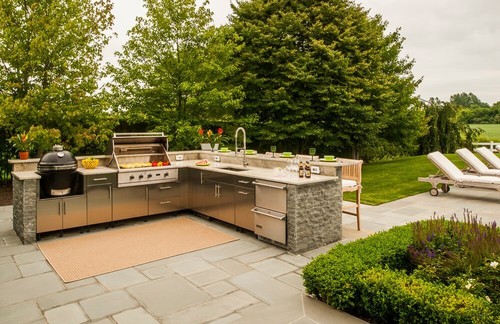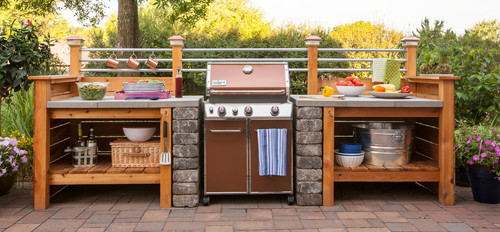8 Outdoor Kitchen Mistakes That Are Sure To Leave a Bad Taste
1. Not planning for the weather
If you're a homeowner in a cooler climate, you won't be able to use your outdoor kitchen all year long. If you live in an area with frigid, snowy winters, you need to plan the space carefully.
Depending on how cold your area gets, electrical components like refrigeration units may need to be winterized and stored in a garage or other enclosed structure.
2. Positioning your kitchen in direct sunlight
Direct sunlight is a no-go for outdoor kitchens.
It’s extremely important, because outdoor refrigeration appliances shouldn’t be fully exposed to sunlight.
On a practical level, direct sunlight can also be annoying. Nobody wants to squint into the sun while trying to enjoy an outdoor happy hour.
If you don’t have natural shade, you can create a pergola or roof structure to help protect your outdoor kitchen from the sun.
3. Building with flammable materials
Thinking of building a wooden island for your outdoor kitchen? Think again.
We strongly advise against building a grill island with wood or other combustible materials.
Instead, opt for a material like metal, brick, or stone.
If you absolutely must use wood for your BBQ island, be sure to install an insulated jacket around the wood to prevent fires—and don’t put your kitchen right up against vinyl siding, another serious fire hazard.
4. Cramming too much into a small space
You don’t need to live on a sprawling estate to create the outdoor dining space of your dreams. If you’re short on space (or money), consider what you really need in your outdoor kitchen, then tailor the space to your priorities and your budget.
5. Planning your outdoor kitchen like an indoor kitchen
Outdoor kitchens have certain quirks that distinguish them from indoor kitchens. For starters, you probably won’t want to use the kind of cabinetry you have inside the house.
Vent hoods for outdoor kitchens need to be more powerful than indoor models.
Outdoor kitchen cabinets are generally deeper than indoor models, typically from 30 to 36 inches deep. Indoors, they are usually around 24 to 27 inches deep.
6. Choosing a grill that's the wrong size
If you’re putting the energy and investment into an outdoor kitchen, don’t skimp on your most important appliance: the grill.
To figure out the right size ask yourself three questions:
- How many people will you normally grill for?
- What’s the maximum number of people you will be grilling for?
- How often do you expect to grill for the maximum number of people?
7. Forgetting to set up the space for entertaining
Chances are, you want an outdoor kitchen for relaxing—not just for cooking. Don’t forget to think about how the space will function for entertaining.
You may also want to incorporate TVs, sound systems, heating and cooling appliances, and decor, depending on your priorities and budget.
8. Dropping the ball on maintenance
A new outdoor kitchen comes with a new list of things to keep spotless. It's important to understand what chores you’re getting into.
If you have stainless-steel appliances, for example, coat them with a protectant to prevent rust. If you aren’t up to the task of regular maintenance, consider hiring a cleaning service.



Comments
Post a Comment